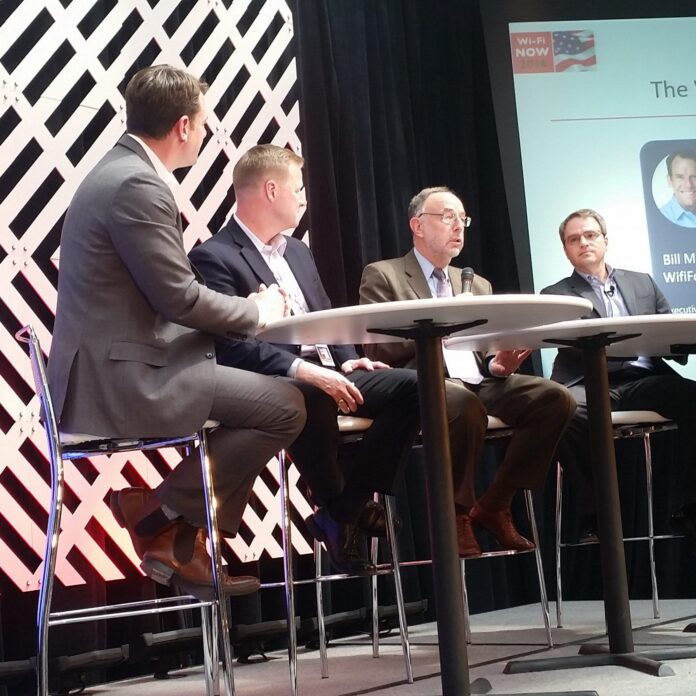The hottest seats in the house at the Wi-Fi Now conference last week were those of the panel members debating the impact of LTE on Wi-Fi as the cellular system moves into unlicensed spectrum at 5 GHz. Wi-Fi Alliance is hosting a workshop today to continue its work on an LTE and Wi-Fi coexistence test plan that is meant to ensure the two technologies play nicely together.
The Federal Communications Commission has pointedly not weighed in on the coexistence question, although it has made clear it is watching as developments progress. At the Wi-Fi Now event, Eduardo Esteves, VP at Qualcomm, praised the FCC’s approach, saying its strategy of telling industry players to work things out among themselves was “exemplary,” and said Wi-Fi Alliance’s testing effort “will set the record straight and clear” and “end the discussions.” Michael Marcus, director at Spectrum Solutions, argued the FCC has sustained too many staff and budgetary cuts to contribute substantively toward ensuring LTE and Wi-Fi coexist well, and that is why it has been so hands off.
Watch an excerpt from the panel discussion below:
[embedyt] http://www.youtube.com/watch?v=tySzdMPvDHA[/embedyt]
Wi-Fi Alliance’s latest workshop is set for today in San Jose, California, as it moves through the process of developing a repeatable test plan to understand LTE/Wi-Fi interactions that protect Wi-Fi.
“The primary concern around other technologies operating in unlicensed spectrum is that it’s absolutely critical that [they] behave fairly toward one another and that they coexist well,” said Kevin Robinson, VP of marketing for Wi-Fi Alliance. “I think everybody understands that point. No matter who you talk to, they understand that you have to protect Wi-Fi. There are billions of Wi-Fi users and it is critical that they continue to have the ability to use Wi-Fi for their connectivity.”
Wi-Fi Alliance in March released an “alpha” draft test procedure for ensuring coexistence that contained more than 100 individual tests “covering all aspects of Wi-Fi coexistence, including channel selection, dynamic channel sharing and Wi-Fi calling,” according to a recent Ericsson filing with the Federal Communications Commission. The equipment vendor complained the proposed tests also included some that did not pertain directly to Wi-Fi coexistence, but to what information a device displays; and that other tests aren’t technology neutral. Wi-Fi Alliance is in the process of wading through the alpha plan with hopes of delivering a final test plan this summer that could be executed by any test lab – although Ericsson is skeptical the plan will be completed before mid-August at the earliest, according to its filing.
In addition to working on the plan itself, Wi-Fi Alliance is also working in parallel to qualify at least one third-party test lab to provide coexistence testing as soon as the final plan is in place, according to a recent filing it made with the FCC.
Broadcom, which is in the process of being acquired by Avago, recently submitted a fresh round of test results to the FCC based on the Wi-Fi Alliance draft test. Chris Symanski, director of government affairs for Broadcom, acknowledged the Wi-Fi Alliance’s test plan is not fully completed and can’t currently be relied upon to prove or not prove coexistence, but said it was the best basis for testing available when Broadcom conducted its tests. Symanski said Broadcom’s numbers show that particularly in the outdoor environment, Wi-Fi power signals tend to be much lower than the levels at which LTE-U is designed to detect them – so that even when a Wi-Fi user could get decent experience on a channel at low power, LTE-U will assume no Wi-Fi is present and behave accordingly. Even license-assisted access technology, which has a built-in “listen-before-talk” feature, may step on Wi-Fi’s toes due to disparities in signal levels, Symanski added.
“At the end of the day, the impact of this is going to be felt by the users,” Symanski said. “You’re not going to have the OEM going out on site with a support team, saying, ‘hey, that router you bought isn’t working anymore.’ It’s going to be felt by the users.”
Symanski did note, however, that standards will continue to evolve and certification processes can also stipulate more courtesy in LTE over unlicensed than are required by official standards.
“The idea would be that if you find out this is detrimental, things can still be done when you deploy. And the standards process isn’t static,” Symanski said.

